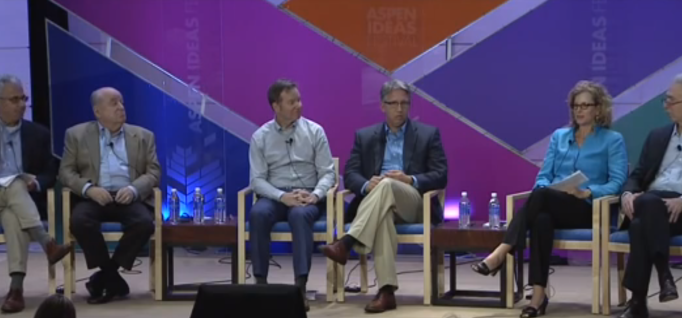Leaders Discuss Big Ideas in Community College Reform
By AACC Staff
September 3, 2014
Aspen Ideas Festival brings education leaders together to tackle challenges of college completion and workforce success.
At this year’s Aspen Ideas Festival, some 3,000 thought leaders and influencers gathered to discuss important global issues. One of the topics on the agenda was higher education. A panel entitled Who is College for, Anymore? (see video below) convened college presidents and other leaders to discuss higher education’s most pressing challenges, from college completion to funding.
Carrie Besnette Hauser, president and CEO of Colorado Mountain College, framed the issues facing the nation’s community colleges this way:
“We are under serious pressure to increase outcomes. Community colleges cannot be a place where a degree dies. We have to make sure that if a student is a degree- or certificate-seeking student that they actually finish or they transfer.”
At AACC, we agree. That’s one of the reasons we put the tough task of improving completion rates at the top of our list of recommendations for community college reform. (Read all seven recommendations.)
If our colleges truly want to meet the challenge of dramatically increasing the number of degrees, certificates and transfers attained, it’s incumbent upon all of us to fundamentally redesign the student experience, to create pathways that support individual learners from the moment they walk through our doors until they achieve their academic goals.
That work is already underway at many community colleges. Case in point:
At City University of New York administrators have doubled completion rates for students enrolled in its Accelerated Study in Associate Programs initiative. Students are grouped in cohorts according to major and attend courses on a consolidated class schedule in the mornings, afternoons or evenings. This enables students to collaborate more freely with classmates and provides additional flexibility around work and other professional and family obligations.
Closing the skills gap
Of course, improving completion rates only gets us part of the way to the ultimate goal: helping students turn their educations into sustainable careers.
At AACC, we recognize that the key to addressing the U.S. skills gap lies in our ability to ensure that all students get the training and skills they need to qualify for the most competitive jobs — particularly in high-demand career fields, such as science, technology, engineering and mathematics (STEM).
One example is the New Mathways Project in Texas. A joint effort of The University of Texas at Austin and the Texas Association of Community Colleges, the project aims to develop and implement three accelerated math pathways — statistics, quantitative literacy and STEM — to align students’ courses specifically with their credential or career objectives.
For more promising practices and examples of important community college reforms, download AACC’s Implementation Guide: Empowering Community Colleges to Build the Nation’s Future. And be sure to watch the video from this year’s Aspen Ideas Festival below.












